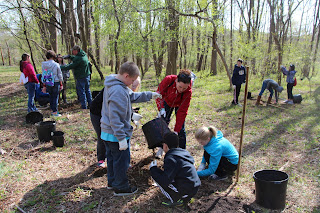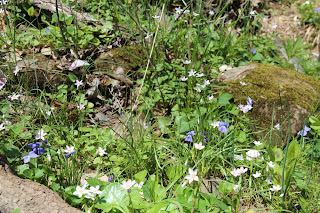 |
| Trail bridge and bluebells |
 |
| Virginia Bluebell |
 |
| Spring-beauty |
 |
| De-silting basin wall |
 |
| Bluebells amid Ostrich Ferns (Metteuccia struthiopteris) |
 |
| Pawpaw flowers |
 |
| A young family cruising the Schuylkill River |
 |
| Who needs a yellow brick road? |
 |
| Trail bridge and bluebells |
 |
| Virginia Bluebell |
 |
| Spring-beauty |
 |
| De-silting basin wall |
 |
| Bluebells amid Ostrich Ferns (Metteuccia struthiopteris) |
 |
| Pawpaw flowers |
 |
| A young family cruising the Schuylkill River |
 |
| Who needs a yellow brick road? |
 |
| Stewardship Assistant Chris planting a tree aided by local 6th-graders |
 |
| Smaller trees require smaller holes - always a consideration with 6th-graders |
 |
| Chris positioning a deer-proofing cage while a student readies a stake |
 |
| At any one time, there were a dozen students planting trees |
 |
| A view upstream along "my" creek |
 |
| A mossy rock garden with violets (Viola spp.) spring-beauties (Claytonia virginica) |
 |
| Trash collected by Viridian Energy volunteers |
 |
| Round Meadow Run, the tributary where I worked, near its mouth |
 |
| Viridian Energy volunteers |
 |
| Round Meadow Run (foreground) joining "my" creek (right) |
 |
| "My" creek is too large to ford easily, so volunteers from Planet Aid used a downed tree |
 |
| Heading back for lunch |
 |
| The three Planet Aid volunteers; it's not apparent in the image, but Dave (center) had fallen in the creek |
 |
| Very pregnant Lavonne (left), our marketing guru, and Kali distributed t-shirts |
 |
| Lunch in the picnic area |
 |
| Amy, a board member of Friends of High School Park showing off a new informational sign |
 |
| This meadow is not going to "cut the mustard" |
 |
| Stopping to discuss the value of meadows as a source of bird food: insects and caterpillars |
 |
| Some of the same meadow species, now up close and personal |
 |
| Reviewing the plans for the demonstration garden |
 |
| The Tookany Creek Trail bordered by highly invasive lesser celandine (Ranunculus ficaria) |
 |
| Siebold viburnum about to bloom |
 |
| A father and his two sons fishing in the county park downstream of "my" preserve |
 |
| The entrance station and picnickers at the county park |
 |
| Cattle at the teaching farm |
 |
| Lesser celandine carpeting a dry, upland wooded slope |
 |
| Lots of folks enjoying the stream |
 |
| Lesser celandine in its "rightful" place along the creek |
 |
| Wild Turkeys and Siberian squill (Scilla siberica) |
 |
| One of the things I'll miss when we move to Colorado (but which might be replaced by elk!) |
 |
| Exploring a stand of old-growth American beech before spring bud break |
 |
| Chris (second from right) and Handel (third from right) discoursing on planting trees |
 |
| Steven Handel lending his support to a large, old beech |
 |
| On the floodplain |
 |
| Examining celandine up close and personal |
 |
| I wish I could fish on a Monday afternoon |
 |
| Kali with Goatie (rear) and Clarisse |
